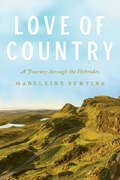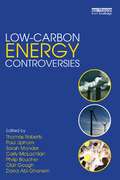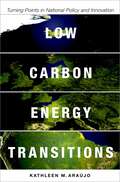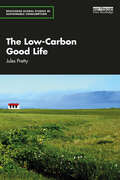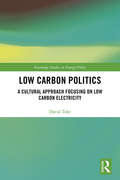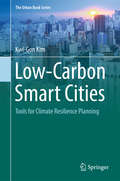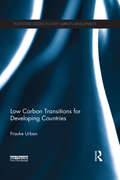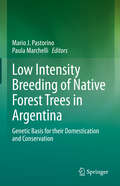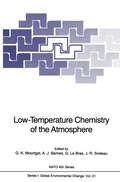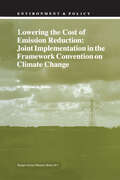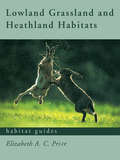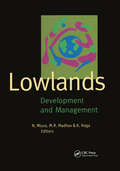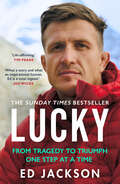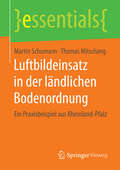- Table View
- List View
Love of Country: A Journey through the Hebrides
by Madeleine BuntingFew landscapes are as striking as that of the Hebrides, the hundreds of small islands that speckle the waters off Scotland’s northwest coast. The jagged, rocky cliffs and roiling waves serve as a reminder of the islands’ dramatic geological history, inspiring awe and dread in those drawn there. With Britain at their back and facing the Atlantic, the Hebrides were at the center of ancient shipping routes and have a remarkable cultural history as well, as a meeting place for countless cultures that interacted with a long, rich Gaelic tradition. After years of hearing about Scotland as a place deeply interwoven with the story of her family, Madeleine Bunting was driven to see for herself this place so symbolic and full of history. Most people travel in search of the unfamiliar, to leave behind the comfort of what’s known to explore some suitably far-flung corner of the globe. From the first pages, it’s clear that Madeleine Bunting’s Love of Country marks a different kind of journey—one where all paths lead to a closer understanding of home, but a home bigger than Bunting’s corner of Britain, the drizzly, busy streets of London with their scream of sirens and high-rise developments crowding the sky. Over six years, Bunting returned again and again to the Hebrides, fascinated by the question of what it means to belong there, a question that on these islands has been fraught with tenacious resistance and sometimes tragedy. With great sensitivity, she takes readers through the Hebrides’ history of dispossession and displacement, a history that can be understand only in the context of Britain’s imperial past, and she shows how the Hebrides have been repeatedly used to define and imagine Britain. In recent years, the relationship between Britain and Scotland has been subject to its most testing scrutiny, and Bunting’s travels became a way to reflect on what might be lost and what new possibilities might lie ahead. For all who have wondered how it might feel to stand face-out at the edge of home, Love of Country is a revelatory journey through one of the world’s most remote, beautiful landscapes that encourages us to think of the many identities we wear as we walk our paths, and how it is possible to belong to many places while at the same time not wholly belonging to any.
Love of Country: A Journey through the Hebrides
by Madeleine BuntingFew landscapes are as striking as that of the Hebrides, the hundreds of small islands that speckle the waters off Scotland’s northwest coast. The jagged, rocky cliffs and roiling waves serve as a reminder of the islands’ dramatic geological history, inspiring awe and dread in those drawn there. With Britain at their back and facing the Atlantic, the Hebrides were at the center of ancient shipping routes and have a remarkable cultural history as well, as a meeting place for countless cultures that interacted with a long, rich Gaelic tradition. After years of hearing about Scotland as a place deeply interwoven with the story of her family, Madeleine Bunting was driven to see for herself this place so symbolic and full of history. Most people travel in search of the unfamiliar, to leave behind the comfort of what’s known to explore some suitably far-flung corner of the globe. From the first pages, it’s clear that Madeleine Bunting’s Love of Country marks a different kind of journey—one where all paths lead to a closer understanding of home, but a home bigger than Bunting’s corner of Britain, the drizzly, busy streets of London with their scream of sirens and high-rise developments crowding the sky. Over six years, Bunting returned again and again to the Hebrides, fascinated by the question of what it means to belong there, a question that on these islands has been fraught with tenacious resistance and sometimes tragedy. With great sensitivity, she takes readers through the Hebrides’ history of dispossession and displacement, a history that can be understand only in the context of Britain’s imperial past, and she shows how the Hebrides have been repeatedly used to define and imagine Britain. In recent years, the relationship between Britain and Scotland has been subject to its most testing scrutiny, and Bunting’s travels became a way to reflect on what might be lost and what new possibilities might lie ahead. For all who have wondered how it might feel to stand face-out at the edge of home, Love of Country is a revelatory journey through one of the world’s most remote, beautiful landscapes that encourages us to think of the many identities we wear as we walk our paths, and how it is possible to belong to many places while at the same time not wholly belonging to any.
Love of Country: A Journey through the Hebrides
by Madeleine BuntingFew landscapes are as striking as that of the Hebrides, the hundreds of small islands that speckle the waters off Scotland’s northwest coast. The jagged, rocky cliffs and roiling waves serve as a reminder of the islands’ dramatic geological history, inspiring awe and dread in those drawn there. With Britain at their back and facing the Atlantic, the Hebrides were at the center of ancient shipping routes and have a remarkable cultural history as well, as a meeting place for countless cultures that interacted with a long, rich Gaelic tradition. After years of hearing about Scotland as a place deeply interwoven with the story of her family, Madeleine Bunting was driven to see for herself this place so symbolic and full of history. Most people travel in search of the unfamiliar, to leave behind the comfort of what’s known to explore some suitably far-flung corner of the globe. From the first pages, it’s clear that Madeleine Bunting’s Love of Country marks a different kind of journey—one where all paths lead to a closer understanding of home, but a home bigger than Bunting’s corner of Britain, the drizzly, busy streets of London with their scream of sirens and high-rise developments crowding the sky. Over six years, Bunting returned again and again to the Hebrides, fascinated by the question of what it means to belong there, a question that on these islands has been fraught with tenacious resistance and sometimes tragedy. With great sensitivity, she takes readers through the Hebrides’ history of dispossession and displacement, a history that can be understand only in the context of Britain’s imperial past, and she shows how the Hebrides have been repeatedly used to define and imagine Britain. In recent years, the relationship between Britain and Scotland has been subject to its most testing scrutiny, and Bunting’s travels became a way to reflect on what might be lost and what new possibilities might lie ahead. For all who have wondered how it might feel to stand face-out at the edge of home, Love of Country is a revelatory journey through one of the world’s most remote, beautiful landscapes that encourages us to think of the many identities we wear as we walk our paths, and how it is possible to belong to many places while at the same time not wholly belonging to any.
Loved Clothes Last: How the Joy of Rewearing and Repairing Your Clothes Can Be a Revolutionary Act
by Orsola de Castro'It's important that everyone with an interest in fashion reads this book so we can live on a healthier planet' Arizona Muse 'The most timely book you'll read this year' India Knight* * * * * Running out of space for the clothes you can't stop buying? Curious about how you can make a difference to the environmental challenges our planet faces? Join Orsola's care revolution and learn to make the clothes you love, last longer.This book will equip you with a myriad of ways to mend, rewear and breathe new life into your wardrobe to achieve a more sustainable lifestyle. By teaching you to scrutinise your shopping habits and make sustainable purchases, she will inspire you to buy better, care more and reduce your carbon footprint by simply making your loved clothes last longer.Following Orsola's practical tips to lavish care and attention on the clothes you already own will not only have a positive environmental impact, but will be personally rewarding too: hand wash, steam and spot clean your clothes, air dry instead of tumble drying, or revive your clothes by sewing or crocheting.Fast fashion leaves behind a trail of human and environmental exploitation. Our wardrobes don't have to be the finish line; they can be a starting point. We can all care, repair and rewear. Do you accept the challenge?* * * * *'An incredibly thoughtful, must-read guide' Kenya Hunt'A must read for anyone who wants to understand the fashion industry as an outsider and wants direction as to where we go next' Aja Barber
Low-Carbon Energy Controversies
by Thomas Roberts Dana Abi Ghanem Paul Upham Carly Mclachlan Sarah Mander Clair Gough Philip BoucherGovernments, big business and communities are coming under increased pressure to develop low carbon energy supply technologies. Within the context of the climate change debate a delicate balance has to be reached between local environmental protection and our need for reliable low carbon energy. This books brings together ten years of research conducted by the Tyndall Centre for Climate Change Research and uses a range of case studies from carbon capture and storage to on-shore wind farms to explore the complex nature of disputes between a wide variety of stakeholder groups. Topics covered include: the importance of context the relationship between risk and trust sense of place role of the media An invaluable resource for researchers and readers in local or national government, industry or community groups who wish to deepen their understanding of controversy around low carbon technology and how to overcome it.
Low-Carbon Energy Controversies
by Thomas Roberts Paul Upham Sarah Mander Carly McLachlan Philip Boucher Clair Gough Dana Abi GhanemGovernments, big business and communities are coming under increased pressure to develop low carbon energy supply technologies. Within the context of the climate change debate a delicate balance has to be reached between local environmental protection and our need for reliable low carbon energy. This books brings together ten years of research conducted by the Tyndall Centre for Climate Change Research and uses a range of case studies from carbon capture and storage to on-shore wind farms to explore the complex nature of disputes between a wide variety of stakeholder groups. Topics covered include: the importance of context the relationship between risk and trust sense of place role of the media An invaluable resource for researchers and readers in local or national government, industry or community groups who wish to deepen their understanding of controversy around low carbon technology and how to overcome it.
Low Carbon Energy Transitions: Turning Points in National Policy and Innovation
by Kathleen AraújoThe world is at a pivotal crossroad in energy choices. There is a strong sense that our use of energy must be more sustainable. Moreover, many also broadly agree that a way must be found to rely increasingly on lower carbon energy sources. However, no single or clear solution exists on the means to carry out such a shift at either a national or international level. Traditional energy planning (when done) has revolved around limited cost projections that often fail to take longer term evidence and interactions of a wider set of factors into account. The good news is that evidence does exist on such change in case studies of different nations shifting toward low-carbon energy approaches. In fact, such shifts can occur quite quickly at times, alongside industrial and societal advance, innovation, and policy learning. These types of insights will be important for informing energy debates and decision-making going forward. Low Carbon Energy Transitions: Turning Points in National Policy and Innovation takes an in-depth look at four energy transitions that have occurred since the global oil crisis of 1973: Brazilian biofuels, Danish wind power, French nuclear power, and Icelandic geothermal energy. With these cases, Dr. Araújo argues that significant nationwide shifts to low-carbon energy can occur in under fifteen years, and that technological complexity is not necessarily a major impediment to such shifts. Dr. Araújo draws on more than five years of research, and interviews with over 120 different scientists, government workers, academics, and members of civil society in completing this study. Low Carbon Energy Transitions is written for for professionals in energy, the environment and policy as well as for students and citizens who are interested in critical decisions about energy sustainability. Technology briefings are provided for each of the major technologies in this book, so that scientific and non-scientific readers can engage in more even discussions about the choices that are involved.
Low Carbon Energy Transitions: Turning Points in National Policy and Innovation
by Kathleen AraújoThe world is at a pivotal crossroad in energy choices. There is a strong sense that our use of energy must be more sustainable. Moreover, many also broadly agree that a way must be found to rely increasingly on lower carbon energy sources. However, no single or clear solution exists on the means to carry out such a shift at either a national or international level. Traditional energy planning (when done) has revolved around limited cost projections that often fail to take longer term evidence and interactions of a wider set of factors into account. The good news is that evidence does exist on such change in case studies of different nations shifting toward low-carbon energy approaches. In fact, such shifts can occur quite quickly at times, alongside industrial and societal advance, innovation, and policy learning. These types of insights will be important for informing energy debates and decision-making going forward. Low Carbon Energy Transitions: Turning Points in National Policy and Innovation takes an in-depth look at four energy transitions that have occurred since the global oil crisis of 1973: Brazilian biofuels, Danish wind power, French nuclear power, and Icelandic geothermal energy. With these cases, Dr. Araújo argues that significant nationwide shifts to low-carbon energy can occur in under fifteen years, and that technological complexity is not necessarily a major impediment to such shifts. Dr. Araújo draws on more than five years of research, and interviews with over 120 different scientists, government workers, academics, and members of civil society in completing this study. Low Carbon Energy Transitions is written for for professionals in energy, the environment and policy as well as for students and citizens who are interested in critical decisions about energy sustainability. Technology briefings are provided for each of the major technologies in this book, so that scientific and non-scientific readers can engage in more even discussions about the choices that are involved.
The Low-Carbon Good Life (Routledge-SCORAI Studies in Sustainable Consumption)
by Jules PrettyThe Low-Carbon Good Life is about how to reverse and repair four interlocking crises arising from modern material consumption: the climate crisis, growing inequality, biodiversity loss and food-related ill-health. Across the world today and throughout history, good lives are characterised by healthy food, connections to nature, being active, togetherness, personal growth, a spiritual framework and sustainable consumption. A low-carbon good life offers opportunities to live in ways that will bring greater happiness and contentment. Slower ways of living await. A global target of no more than one tonne of carbon per person would allow the poorest to consume more and everyone to find our models of low-carbon good lives. But dropping old habits is hard, and large-scale impacts will need fresh forms of public engagement and citizen action. Local to national governments need to act; equally, they need pushing by the power and collective action of citizens. Innovative and engaging and written in a style that combines storytelling with scientific evidence, this book will be of great interest to students and scholars of climate change, sustainability, environmental economics and sustainable consumption, as well as non-specialist readers concerned about the climate crisis.
The Low-Carbon Good Life (Routledge-SCORAI Studies in Sustainable Consumption)
by Jules PrettyThe Low-Carbon Good Life is about how to reverse and repair four interlocking crises arising from modern material consumption: the climate crisis, growing inequality, biodiversity loss and food-related ill-health. Across the world today and throughout history, good lives are characterised by healthy food, connections to nature, being active, togetherness, personal growth, a spiritual framework and sustainable consumption. A low-carbon good life offers opportunities to live in ways that will bring greater happiness and contentment. Slower ways of living await. A global target of no more than one tonne of carbon per person would allow the poorest to consume more and everyone to find our models of low-carbon good lives. But dropping old habits is hard, and large-scale impacts will need fresh forms of public engagement and citizen action. Local to national governments need to act; equally, they need pushing by the power and collective action of citizens. Innovative and engaging and written in a style that combines storytelling with scientific evidence, this book will be of great interest to students and scholars of climate change, sustainability, environmental economics and sustainable consumption, as well as non-specialist readers concerned about the climate crisis.
Low Carbon Politics: A Cultural Approach Focusing on Low Carbon Electricity (Routledge Studies in Energy Policy)
by David TokeLow Carbon Politics focuses on how policies and institutions have influenced the deployment of renewable energy and nuclear power in the electricity sector. Cultural theory is used to analyse this. Egalitarian pressures have had a profound influence on technological outcomes, not merely in securing the deployment of renewable energy but also in increasing the costs of nuclear power. Whereas in the 1970s it might have been expected that individualist, market based pressures allied to dominant hierarchies would deliver nuclear power as the main response to problems associated with fossil fuels, a surprising combination has emerged. Egalitarian and individualist pressures are, together, leading to increasing levels of deployment of renewable energy. This work finds that electricity monopolies tend to favour nuclear power whereas competitive arrangements are more likely to lead to more renewable energy being deployed. It covers developments in a number of countries including USA, UK, China, South Africa and also Germany and Denmark. This book will be of great relevance to students, academics and policymakers with an interest in energy policy, low carbon politics and climate change.
Low Carbon Politics: A Cultural Approach Focusing on Low Carbon Electricity (Routledge Studies in Energy Policy)
by David TokeLow Carbon Politics focuses on how policies and institutions have influenced the deployment of renewable energy and nuclear power in the electricity sector. Cultural theory is used to analyse this. Egalitarian pressures have had a profound influence on technological outcomes, not merely in securing the deployment of renewable energy but also in increasing the costs of nuclear power. Whereas in the 1970s it might have been expected that individualist, market based pressures allied to dominant hierarchies would deliver nuclear power as the main response to problems associated with fossil fuels, a surprising combination has emerged. Egalitarian and individualist pressures are, together, leading to increasing levels of deployment of renewable energy. This work finds that electricity monopolies tend to favour nuclear power whereas competitive arrangements are more likely to lead to more renewable energy being deployed. It covers developments in a number of countries including USA, UK, China, South Africa and also Germany and Denmark. This book will be of great relevance to students, academics and policymakers with an interest in energy policy, low carbon politics and climate change.
Low-Carbon Smart Cities: Tools for Climate Resilience Planning (The Urban Book Series)
by Kwi-Gon KimThis book aims to integrate climate mitigation and adaptation tools into conventional urban planning. It emphasizes the value and importance of ICT as connected technology. The author believes that ICT and IOT can facilitate controlling climate change attributes when deployed with appropriate ingredients and composition in cities in an integrated comprehensive manner. It was written with the author's firm belief that cities play an important role in mitigating climate change by reducing energy consumption, promoting the use of renewable energy sources, or by trading emission permits and selling Certified Emission Rights (CERs). This book looks at green growth based on the circular economy using green smart technology as a sustainable tool for green economic development. Also for climate change adaptation, cities have to take actions to reduce the adverse impacts of climate change on people, property and ecosystems in the urban planning process.It has been written with the author's works for Urban Environment Accords (UEA) and International Urban Training Center (IUTC) in collaboration with UNEP, World Bank, UNFCCC and UN-HABITAT. It can be used as a training source book for city climate planners and urban practitioners of local governments. It will be utilized as a more practical guidebook for climate change policy makers as well as a futuristic research agenda for next generations.
Low Carbon Transitions for Developing Countries (Routledge Studies in Low Carbon Development)
by Frauke UrbanGlobal climate change is one of the greatest challenges of our times and in order to tackle this carbon emissions need to be mitigated. China and India have recently become some of the world’s largest greenhouse gas emitters. Transitions to low carbon energy, for reducing emissions that lead to climate change, are therefore an urgent priority for China and India and at a global level. This is the first book focusing on low carbon energy transitions for emerging economies such as China and India, assessing the opportunities and barriers for transitions to renewable and low carbon energy as climate change mitigation options. It uses energy modelling to assess the China’s power sector, the economy of Beijing and rural Indian households that do not have access to electricity. The research evaluates the environmental, technical, socio-economic and policy implications of these low carbon transitions, concluding that they are possible in China and India and they can considerably contribute to climate change mitigation. This interdisciplinary book will be of interest to scholars, students, practitioners and policy-makers working in the fields of energy and development, energy policy, energy studies and modelling, climate policy, climate change mitigation, climate change and development, low carbon development, sustainable development, environment and development and environmental management.
Low Carbon Transitions for Developing Countries (Routledge Studies in Low Carbon Development)
by Frauke UrbanGlobal climate change is one of the greatest challenges of our times and in order to tackle this carbon emissions need to be mitigated. China and India have recently become some of the world’s largest greenhouse gas emitters. Transitions to low carbon energy, for reducing emissions that lead to climate change, are therefore an urgent priority for China and India and at a global level. This is the first book focusing on low carbon energy transitions for emerging economies such as China and India, assessing the opportunities and barriers for transitions to renewable and low carbon energy as climate change mitigation options. It uses energy modelling to assess the China’s power sector, the economy of Beijing and rural Indian households that do not have access to electricity. The research evaluates the environmental, technical, socio-economic and policy implications of these low carbon transitions, concluding that they are possible in China and India and they can considerably contribute to climate change mitigation. This interdisciplinary book will be of interest to scholars, students, practitioners and policy-makers working in the fields of energy and development, energy policy, energy studies and modelling, climate policy, climate change mitigation, climate change and development, low carbon development, sustainable development, environment and development and environmental management.
Low Intensity Breeding of Native Forest Trees in Argentina: Genetic Basis for their Domestication and Conservation
by Mario J. Pastorino Paula MarchelliGlobal climate change requires the development of programs that consider the active restoration of degraded forests and the use of native trees in afforestation to preserve the natural environment. International commitments like the UN REDD program, the Montréal Process and the Convention on Biological Diversity call for the breeding of species rarely contemplated by large industrial companies. Low-intensity breeding is the most rational strategy for those species: simple but robust, and not dependent on continuously increasing funding, and therefore effective even with a relatively small budget. It commonly focuses on high genetic diversity rather than improving economic traits and adaptability rather than productivity. Controlled crosses with full pedigrees typical of high-intensity breeding are replaced by open pollination. This book presents state-of-the-art breeding strategies from the last two decades for several forest tree species of prime importance in the natural forests of Argentina. They are distributed in the three main forestry ecoregions of the country: the subtropical dry forest (Chaco), the subtropical rain forests (Yungas and Alto Paraná rainforests) and the temperate forests of Patagonia. The book also discusses the genetic patterns of the selected species defined using genetic markers together with the analysis of the variation in quantitative traits. Further, it examines the crucial features of their reproductive biology, such as the mating system and gene flow and describes the current breeding programs. Lastly, it presents the latest developments in genetic resources and their emerging applications, concluding with some reflections and perspectives related to the conditioning imposed by climate change.
Low-Temperature Chemistry of the Atmosphere (Nato ASI Subseries I: #21)
by Geert K. Moortgat Austin J. Barnes Georges Le Bras John R. SodeauPresented here are authoritative and up-to-date assessments of the homogenous and heterogenous chemical and physical processes occuring in the troposphere and stratosphere, especially during the "ozone hole" event. The book begins with an overview of atmospheric chemistry, followed by reviews of relevant homogenous reactions in the gas phase and the microphysics and physical chemistry of heterogenous processes that occur on, or in aerosols, rain and ice. Low temperature laboratory studies are compared with related fieldwork measurements, particularly in relation to the formation and composition of polar stratospheric clouds. Also discussed are measurements in glacial ice. Finally chemical modelling of the troposphere and stratosphere, including heterogenous processes, is reviewed.
Lowering the Cost of Emission Reduction: Joint Implementation in the Framework Convention on Climate Change (Environment & Policy #10)
by M.A. RidleyLowering the Cost of Emission Reduction by Dr Michael Ridley investigates a novel way to reduce the cost of carbon dioxide and sulphur dioxide emission reduction. This book asks whether allowing countries to substitute emission reduction undertaken abroad in lieu of emission reduction at home will reduce the cost of emission reduction and allow more rapid and acute falls in pollution. Analysing US Department of Energy data on US emission reduction projects undertaken in Eastern Europe and Central America, this book explains differences in the cost of emission reduction by method and by country. The book sets out the conditions that would allow a joint implementation system to evolve into a full-blown tradable permits system. Political and practical objections to joint implementation are aired and addressed. This book is targeted at the environmental policy community, government officials, academics, the NGO community, economists and financiers, members of large corporations and museum educators everywhere.
Lowland Grassland and Heathland Habitats (Habitat Guides)
by Elizabeth PriceGrasslands are everywhere: agricultural land, playing fields and road verges; but while species-poor, intensively managed grasslands are widespread, colourful semi-natural grasslands and heathlands, buzzing with life, are scarce. These semi-natural habitats are ancient, cultural landscapes, which are of considerable, if not international importance for biodiversity. However, despite targets for the conservation and restoration of these valuable grasslands and heathlands, these habitats continue to decline before our eyes. Lowland Grassland and Heathland Habitats contrasts the uniformity of intensively managed grassland with the diversity of traditionally managed grasslands and heathlands. It examines topics of concern to the ecologist or habitat manager such as causes of the loss and deterioration of these habitats, including inappropriate management, eutrophication and climate change. It then evaluates opportunities for positive change, such as conservation, restoration and creation. A series of case-studies illustrates the pressures on some lowland grassland and heathland habitat types and looks at ways to enhance them for biodiversity. This habitat guide features illustrated species boxes of typical plants and animals, as well as a full species list, a series of projects on the ecology of grassland and heathland species, a colour plate section, up-to-date references and information, and a full glossary. It will provide students and environmentalists with a deeper understanding of the nature and importance of lowland grasslands and heathlands.
Lowland Grassland and Heathland Habitats (Habitat Guides)
by Elizabeth PriceGrasslands are everywhere: agricultural land, playing fields and road verges; but while species-poor, intensively managed grasslands are widespread, colourful semi-natural grasslands and heathlands, buzzing with life, are scarce. These semi-natural habitats are ancient, cultural landscapes, which are of considerable, if not international importance for biodiversity. However, despite targets for the conservation and restoration of these valuable grasslands and heathlands, these habitats continue to decline before our eyes. Lowland Grassland and Heathland Habitats contrasts the uniformity of intensively managed grassland with the diversity of traditionally managed grasslands and heathlands. It examines topics of concern to the ecologist or habitat manager such as causes of the loss and deterioration of these habitats, including inappropriate management, eutrophication and climate change. It then evaluates opportunities for positive change, such as conservation, restoration and creation. A series of case-studies illustrates the pressures on some lowland grassland and heathland habitat types and looks at ways to enhance them for biodiversity. This habitat guide features illustrated species boxes of typical plants and animals, as well as a full species list, a series of projects on the ecology of grassland and heathland species, a colour plate section, up-to-date references and information, and a full glossary. It will provide students and environmentalists with a deeper understanding of the nature and importance of lowland grasslands and heathlands.
Lowlands
by Kenichi Koga Norihiko Miura Madhira R. MadhavThis text presents up-to-date knowledge regarding lowlands, which are lands affected by fluctuating water levels. By collating and examining relevant information concerning lowlands in one volume, this text should be of use to engineers, planners, managers, administrators and scientists.
Lowlands
by NORIHIKO MIURA; MADHIRA R.MADHAV; KENICHI KOGAThis text presents up-to-date knowledge regarding lowlands, which are lands affected by fluctuating water levels. By collating and examining relevant information concerning lowlands in one volume, this text should be of use to engineers, planners, managers, administrators and scientists.
Lucky
by Ed Jackson‘What a story and what an inspirational human. Ed is a total legend.’ Joe Wicks ‘A life-affirming story . . . inspirational’ Tim Peake From tragedy to triumph, one step at a time – an inspirational story of triumph over adversity against the odds
Luftbildeinsatz in der ländlichen Bodenordnung: Ein Praxisbeispiel aus Rheinland-Pfalz (essentials)
by Martin Schumann Thomas MitschangIn diesem essential beschreiben Martin Schumann und Thomas Mitschang die Verwendung von Luftbildern in der Flurbereinigungsverwaltung Rheinland-Pfalz. Anhand eines Beispiels stellen die Autoren die Bedeutung der Luftbilder für die Planung von Landentwicklungsmaßnahmen dar. Seit den fünfziger Jahren des letzten Jahrhunderts werden Luftbilder für die unterschiedlichen Zwecke eingesetzt. Dabei haben sich die Qualität der Aufnahmen sowie die Auswertungsmöglichkeiten im Laufe der Jahrzehnte verändert.
Luftverschmutzung und Klimaänderung: Auswirkungen auf Flora, Fauna und Mensch
by Alan R. WellburnHier liegt das erste zusammenfassende Buch zu den Auswirkungen von Luftverschmutzung und Klimaänderung auf die Biosphäre vor. Der Schwerpunkt liegt dabei auf der Erläuterung der biochemischen Vorgänge in Pflanze, Tier und Mensch, die durch die jeweiligen Luftschadstoffe ausgelöst werden. Daneben werden aber auch globale Aspekte der Luftverschmutzung wie Treibhauseffekt, saurer Regen, Ozonloch und Waldsterben ausführlich erörtert. Somit erhält der Leser einen umfassenden Einblick in diese fachübergreifende Problematik.
